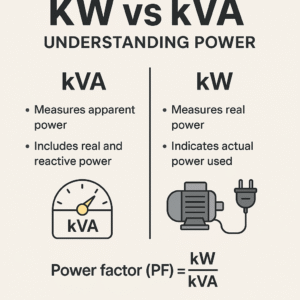Electricians, engineers, and business owners often need clarity on kilowatt (kW) versus kilovolt-ampere (kVA)—two fundamental measurements in electrical power. Here’s a deep dive into the difference, why it matters, and how to apply it in real-world scenarios.
1. What is kW (Kilowatt)?
-
Definition: kW measures real power—the actual energy consumed by electrical devices to perform useful work.
-
Use Cases: Loads such as motors/pumps, microwaves, and lights operate based on kW.
-
Measurement: One kW equals 1,000 watts of real energy use.
2. What is kVA (Kilovolt‑Ampere)?
-
Definition: kVA measures apparent power—the total electrical capacity needed by a system, including both real and reactive power.
-
Use Cases: Commonly used by generators, transformers, and inverters to define capacity.
-
Significance: It represents the maximum power that equipment must be able to handle—even if not all is used for work.
3. The Bridge: Power Factor (PF)
The power factor bridges the gap:
-
PF Value: Ranges from 0–1. A PF of 1 means all power is real. Generators typically run at PF ≈ 0.8.
-
Implication: A 100 kVA generator at PF 0.8 delivers 80 kW real power.
-
PF Importance: Low PF causes higher currents, increasing losses, requiring larger conductors, and possibly leading to utility penalties.
4. Why the Difference Matters
-
Sizing Equipment: Always size systems by apparent power. A motor that needs 10 kW at PF 0.6 draws 16.67 kVA—so wiring and devices must handle the full apparent load.
-
Efficiency & Cost: Low PF means wasted energy and higher costs from utilities and extra losses.
-
Optimizing Systems: Reactive power doesn’t do actual work but must be supplied. PF correction (capacitors, synchronous condensers) can help align power use.
Putting It Into Practice
-
Generator Selection
-
Know the device’s PF (typically 0.8).
-
Match kVA rating based on required kW:
kVA = kW ÷ PF -
For an 80 kW load:
-
-
System Optimization
-
Monitor power factor. If PF is low, consider installing correction capacitors.
-
Aim for PF ≥ 0.9 to reduce system losses and utility penalties.
-
-
Cost-Efficiency
-
Understand that kW reflects your billing and energy usage.
-
kVA and PF affect your infrastructure sizing, system resilience, and operating costs.
-
Key Takeaways
| Term | Measures | Includes | Unit |
|---|---|---|---|
| kW | Real power | Does useful work | Kilowatts |
| kVA | Apparent power | Real + Reactive power | Kilovolt‑Ampere |
| Power Factor (PF) | Efficiency | Ratio of real to apparent power | 0–1 (≈0.8 gen sets) |
Improving PF enhances system efficiency, reduces energy costs, and ensures the right sizing of generators, transformers, and wiring.














